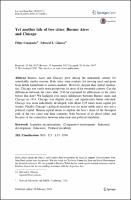Yet another tale of two cities: Buenos Aires and Chicago

Fecha de publicación
2018-02-02Author
Campante, Filipe
Glaeser, Edward L. (Edward Ludwing)
Formato
application/PDF
URL del recurso
http://hdl.handle.net/11651/3220Idioma
eng
Acceso
Acceso abierto
Compartir
Metadata
Show full item recordAbstract
Buenos Aires and Chicago grew during the nineteenth century for remarkably similar reasons. Both cities were conduits for moving meat and grain from fertile hinterlands to eastern markets. However, despite their initial similarities, Chicago was vastly more prosperous for most of the twentieth century. Can the differences between the cities after 1930 be explained by differences in the cities before that date? We highlight four major differences between Buenos Aires and Chicago in 1914. Chicago was slightly richer, and significantly better educated. Chicago was more industrially developed, with about 2.25 times more capital per worker. Finally, Chicago’s political situation was far more stable and it was not a political capital. Human capital seems to explain the lion’s share of the divergent path of the two cities and their countries, both because of its direct effect and because of the connection between education and political instability.
Editorial
Centro de Investigación y Docencia Económicas
Derechos
La revista Latin American Economic Review autoriza a poner en acceso abierto de conformidad con las licencias CREATIVE COMMONS, aprobadas por el Consejo Académico Administrativo del CIDE, las cuales establecen los parámetros de difusión de las obras con fines no comerciales. Lo anterior sin perjuicio de los derechos morales que corresponden a los autores.
Tipo
Artículo

